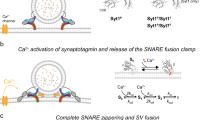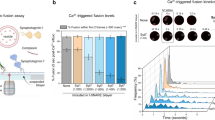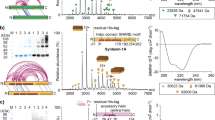Abstract
Complexins constitute a family of four synaptic high-affinity SNARE complex–binding proteins. They positively regulate a late, post-priming step in Ca2+-triggered synchronous neurotransmitter release, but the underlying molecular mechanisms are unclear. We show here that SNARE complex binding of complexin I (CplxI) via its central α-helix is necessary but, unexpectedly, not sufficient for its key function in promoting neurotransmitter release. An accessory α-helix on the N-terminal side of the SNARE complex–binding region has an inhibitory effect on fast synaptic exocytosis, whereas sequences N-terminally adjacent to this helix facilitate Ca2+-triggered release even in the absence of the Ca2+ sensor synaptotagmin-1. Our results indicate that distinct functional domains of CplxI differentially regulate synaptic exocytosis and that, through the interplay between these domains, CplxI carries out a crucial role in fine-tuning Ca2+-triggered fast neurotransmitter release.
This is a preview of subscription content, access via your institution
Access options
Subscribe to this journal
Receive 12 print issues and online access
$209.00 per year
only $17.42 per issue
Buy this article
- Purchase on SpringerLink
- Instant access to full article PDF
Prices may be subject to local taxes which are calculated during checkout








Similar content being viewed by others
References
Jahn, R. & Scheller, R.H. SNAREs - engines for membrane fusion. Nat. Rev. Mol. Cell Biol. 7, 631–643 (2006).
Antonin, W., Fasshauer, D., Becker, S., Jahn, R. & Schneider, T.R. Crystal structure of the endosomal SNARE complex reveals common structural principles of all SNAREs. Nat. Struct. Biol. 9, 107–111 (2002).
Sutton, R.B., Fasshauer, D., Jahn, R. & Brunger, A.T. Crystal structure of a SNARE complex involved in synaptic exocytosis at 2.4 Å resolution. Nature 395, 347–353 (1998).
Rizo, J., Chen, X. & Arac, D. Unraveling the mechanisms of synaptotagmin and SNARE function in neurotransmitter release. Trends Cell Biol. 16, 339–350 (2006).
Fernandez-Chacon, R. et al. Synaptotagmin I functions as a calcium regulator of release probability. Nature 410, 41–49 (2001).
Ishizuka, T., Saisu, H., Odani, S. & Abe, T. Synaphin: a protein associated with the docking/fusion complex in presynaptic terminals. Biochem. Biophys. Res. Commun. 213, 1107–1114 (1995).
Takahashi, S. et al. Identification of two highly homologous presynaptic proteins distinctly localized at the dendritic and somatic synapses. FEBS Lett. 368, 455–460 (1995).
McMahon, H.T., Missler, M., Li, C. & Sudhof, T.C. Complexins: cytosolic proteins that regulate SNAP receptor function. Cell 83, 111–119 (1995).
Reim, K. et al. Structurally and functionally unique complexins at retinal ribbon synapses. J. Cell Biol. 169, 669–680 (2005).
Pabst, S. et al. Rapid and selective binding to the synaptic SNARE complex suggests a modulatory role of complexins in neuroexocytosis. J. Biol. Chem. 277, 7838–7848 (2002).
Pabst, S. et al. Selective interaction of complexin with the neuronal SNARE complex. Determination of the binding regions. J. Biol. Chem. 275, 19808–19818 (2000).
Chen, X. et al. Three-dimensional structure of the complexin/SNARE complex. Neuron 33, 397–409 (2002).
Bracher, A., Kadlec, J., Betz, H. & Weissenhorn, W. X-ray structure of a neuronal complexin-SNARE complex from squid. J. Biol. Chem. 277, 26517–26523 (2002).
Hu, K., Carroll, J., Rickman, C. & Davletov, B. Action of complexin on SNARE complex. J. Biol. Chem. 277, 41652–41656 (2002).
Bowen, M.E., Weninger, K., Ernst, J., Chu, S. & Brunger, T.A. Single molecule studies of synaptotagmin and complexin binding to the SNARE complex. Biophys. J. 89, 690–702 (2005).
Reim, K. et al. Complexins regulate a late step in Ca2+-dependent neurotransmitter release. Cell 104, 71–81 (2001).
Tokumaru, H. et al. SNARE complex oligomerization by synaphin/complexin is essential for synaptic vesicle exocytosis. Cell 104, 421–432 (2001).
Tadokoro, S., Nakanishi, M. & Hirashima, N. Complexin II facilitates exocytotic release in mast cells by enhancing Ca2+ sensitivity of the fusion process. J. Cell Sci. 118, 2239–2246 (2005).
Itakura, M., Misawa, H., Sekiguchi, M., Takahashi, S. & Takahashi, M. Transfection analysis of functional roles of complexin I and II in the exocytosis of two different types of secretory vesicles. Biochem. Biophys. Res. Commun. 265, 691–696 (1999).
Ono, S. et al. Regulatory roles of complexins in neurotransmitter release from mature presynaptic nerve terminals. Eur. J. Neurosci. 10, 2143–2152 (1998).
Giraudo, C.G., Eng, W.S., Melia, T.J. & Rothman, J.E. A clamping mechanism involved in SNARE-dependent exocytosis. Science 313, 676–680 (2006).
Schaub, J.R., Lu, X., Doneske, B., Shin, Y.K. & McNew, J.A. Hemifusion arrest by complexin is relieved by Ca2+-synaptotagmin I. Nat. Struct. Mol. Biol. 13, 748–750 (2006).
Tang, J. et al. A complexin/synaptotagmin 1 switch controls fast synaptic vesicle exocytosis. Cell 126, 1175–1187 (2006).
Geppert, M. et al. Synaptotagmin I: a major Ca2+ sensor for transmitter release at a central synapse. Cell 79, 717–727 (1994).
Yoshihara, M. & Littleton, J.T. Synaptotagmin I functions as a calcium sensor to synchronize neurotransmitter release. Neuron 36, 897–908 (2002).
Sudhof, T.C. The synaptic vesicle cycle. Annu. Rev. Neurosci. 27, 509–547 (2004).
Ashery, U., Betz, A., Xu, T., Brose, N. & Rettig, J. An efficient method for infection of adrenal chromaffin cells using the Semliki Forest virus gene expression system. Eur. J. Cell Biol. 78, 525–532 (1999).
Rosenmund, C. & Stevens, C.F. Definition of the readily releasable pool of vesicles at hippocampal synapses. Neuron 16, 1197–1207 (1996).
Morton, A.J. & Edwardson, J.M. Progressive depletion of complexin II in a transgenic mouse model of Huntington's disease. J. Neurochem. 76, 166–172 (2001).
Spee, J.H., de Vos, W.M. & Kuipers, O.P. Efficient random mutagenesis method with adjustable mutation frequency by use of PCR and dITP. Nucleic Acids Res. 21, 777–778 (1993).
Goda, Y. & Stevens, C.F. Two components of transmitter release at a central synapse. Proc. Natl. Acad. Sci. USA 91, 12942–12946 (1994).
Shin, O.H. et al. Sr2+ binding to the Ca2+ binding site of the synaptotagmin 1 C2B domain triggers fast exocytosis without stimulating SNARE interactions. Neuron 37, 99–108 (2003).
Sorensen, J.B. et al. Sequential N- to C-terminal SNARE complex assembly drives priming and fusion of secretory vesicles. EMBO J. 25, 955–966 (2006).
Lin, R.C. & Scheller, R.H. Structural organization of the synaptic exocytosis core complex. Neuron 19, 1087–1094 (1997).
Hanson, P.I., Roth, R., Morisaki, H., Jahn, R. & Heuser, J.E. Structure and conformational changes in NSF and its membrane receptor complexes visualized by quick-freeze/deep-etch electron microscopy. Cell 90, 523–535 (1997).
Xu, T. et al. Inhibition of SNARE complex assembly differentially affects kinetic components of exocytosis. Cell 99, 713–722 (1999).
Littleton, J.T. et al. Temperature-sensitive paralytic mutations demonstrate that synaptic exocytosis requires SNARE complex assembly and disassembly. Neuron 21, 401–413 (1998).
Guan, K.L. & Dixon, J.E. Eukaryotic proteins expressed in Escherichia coli: an improved thrombin cleavage and purification procedure of fusion proteins with glutathione S-transferase. Anal. Biochem. 192, 262–267 (1991).
Bekkers, J.M. & Stevens, C.F. Excitatory and inhibitory autaptic currents in isolated hippocampal neurons maintained in cell culture. Proc. Natl. Acad. Sci. USA 88, 7834–7838 (1991).
Acknowledgements
We thank H. Chen, T. Hellmann, I. Herfort, D. Reuter, S. Wenger and A. Zeuch for excellent technical assistance; F. Benseler, D. Schwerdtfeger and I. Thanhäuser for DNA sequencing and oligonucleotide synthesis; R. Nehring and R. Atkinson for technical advice; H. Bellen for comments on the manuscript and E. Neher for continuous support and advice. This work was supported by the Deutsche Forschungsgemeinschaft (SFB 523/B9 to N.B. and C.R.), a Heisenberg Fellowship (to C.R.), the Brown Foundation (to C.R.), the US National Institutes of Health (NS50655 to C.R., NS37200 to J.R.) and Baylor Research Advocates for Student Scientists and a McNair Fellowship (both to H.-T.C.).
Author information
Authors and Affiliations
Corresponding authors
Supplementary information
Supplementary Text and Figures
Supplementary Figures 1–4, Supplementary Data, Supplementary Methods (PDF 4243 kb)
Rights and permissions
About this article
Cite this article
Xue, M., Reim, K., Chen, X. et al. Distinct domains of complexin I differentially regulate neurotransmitter release. Nat Struct Mol Biol 14, 949–958 (2007). https://doi.org/10.1038/nsmb1292
Received:
Accepted:
Published:
Issue Date:
DOI: https://doi.org/10.1038/nsmb1292
This article is cited by
-
Complexin-1 regulated assembly of single neuronal SNARE complex revealed by single-molecule optical tweezers
Communications Biology (2023)
-
Vesicle trafficking and vesicle fusion: mechanisms, biological functions, and their implications for potential disease therapy
Molecular Biomedicine (2022)
-
The complexin C-terminal amphipathic helix stabilizes the fusion pore open state by sculpting membranes
Nature Structural & Molecular Biology (2022)
-
Focused clamping of a single neuronal SNARE complex by complexin under high mechanical tension
Nature Communications (2018)
-
Should I stop or should I go? The role of complexin in neurotransmitter release
Nature Reviews Neuroscience (2016)



